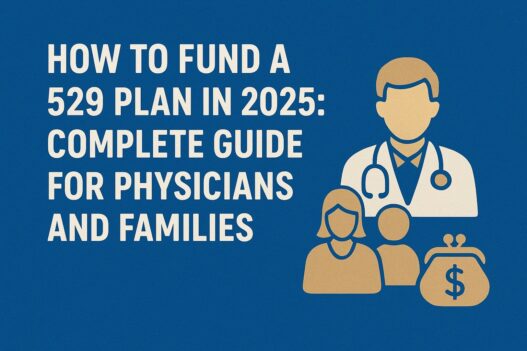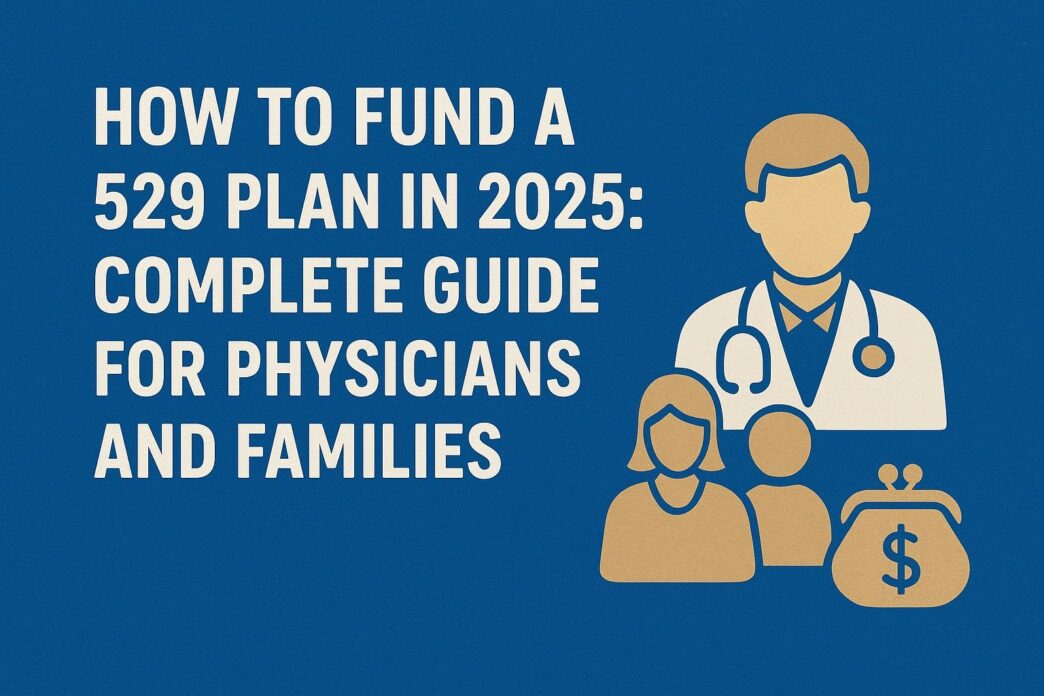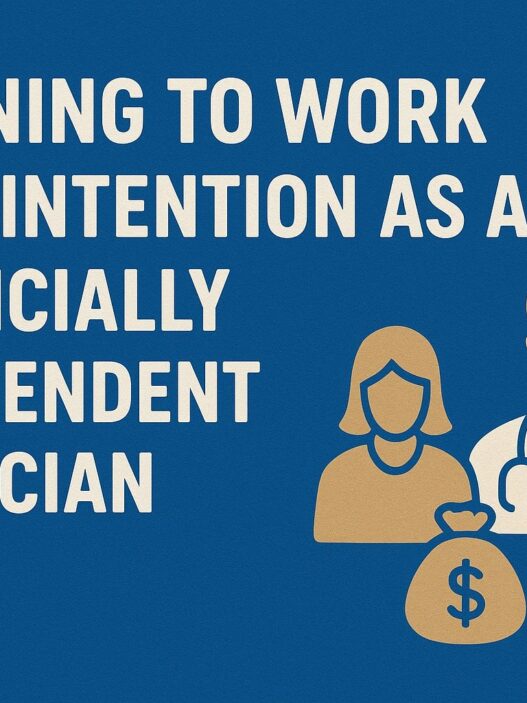Updated for 2025: New OBBBA rules now allow 529 funds to cover physician licensing exams, board certifications, and CME expenses.
Most of us don't stumble onto 529 plans by accident. It usually starts with a colleague mentioning college savings, or a well-meaning relative asking if you've “set something aside for the kids yet.”
The name itself is unassuming, reminiscent of another tax code section you'd rather not have to deal with.
In reality, a 529 is one of the simplest, most tax-friendly ways to fund education. You just have to know how to put money into it without tripping over the fine print.
The Bottom Line: 529 plans offer tax-free growth for education expenses with 2025 contribution limits of $19,000 per person ($38,000 for couples), or up to $95,000 through superfunding. New OBBBA rules expand qualified expenses to include professional licensing and continuing education for physicians.
That last part matters more than ever in light of the recent One Big Beautiful Bill Act (OBBBA). 529s are no longer limited to your child's future tuition payments. Physicians can now use these accounts for their own professional licensing exams, board certifications, and continuing medical education.
This major shift changes the calculus not just for how much you contribute, but also for how you think about 529s as part of your broader financial plan.
If you're new to the financial-planning game, you can learn about the basics of 529s here and here, before reading ahead. Because the questions we'll be focusing on are how to fund a 529 efficiently, how to avoid overdoing it, and how to leverage the new rules in ways that make sense for physicians and their families.
Learn 11 Ways to Invest in Your Child's Future
Step 1: Choose the Right Type of 529 Plan for Your Goals
Before we even get to the part about funding a 529 plan, we need to first discuss the two types of 529s, as this matters for how you'll fund them.
College Savings Plan (Most Popular Option)
This plan works much like a Roth IRA for education. You contribute after-tax dollars, they grow tax-free, and withdrawals for qualified education expenses aren't taxed. These plans also usually come with investment options like mutual funds or ETFs that you can select and adjust.
Best for: Families wanting flexibility, investment growth potential, and the ability to use funds at any accredited institution nationwide.
Prepaid Tuition Plan (Limited Availability)
This plan lets you lock in and prepay according to today's tuition rates at participating public universities. They're less flexible, but they can protect you against runaway tuition inflation. The downside is that they rarely cover room and board, and they limit the options your student will have for schools. Additionally, only a handful of states allow you to save using this plan.
Best for: Families certain their child will attend in-state public universities and wanting protection against tuition increases.
Most people opt for the savings plan version because it offers more flexibility across states and institutions. But the choice should align with your own financial philosophy: are you looking for investment growth, or are you hedging against tuition inflation?
Step 2: Compare 529 Plan Fees to Maximize Returns
Fees can quietly eat away at returns. Some states outsource 529 management to financial firms that tack on program fees, annual account maintenance charges, and fund expense ratios.
Real Cost Example: A physician funding $50,000 for a toddler today could easily lose thousands of dollars in growth over 15 years if their plan charges 1.1% instead of 0.1%. That's the kind of silent leak you don't notice until much later.
According to Brian Preston, a certified financial planner with Preston & Cleveland Wealth Management in McDonough, Ga, “That's free money you're just leaving on the table that could be spent on your child's education.”
How to Find Low-Fee 529 Plans
The rule of thumb is simple: the lower the fees, the better. Direct-sold plans (where you open the account yourself through the state) tend to be cheaper than advisor-sold versions.
You can check a plan's yearly fees and compare it to others using the College Savings Plans Network, which is a resource run by the National Association of State Treasurers.
What to Look For:
- Total expense ratios under 0.20%
- No annual account maintenance fees
- Direct-sold plans vs. advisor-sold
- Low-cost index fund options
Step 3: 529 Plan Contribution Strategy – Fund Consistently but Flexibly
Once the account is open, the next step is how to actually feed it. The standard advice is to set up automatic contributions and let compounding do the work. A few hundred dollars a month over 15 years snowballs into a meaningful sum with market growth.
The Power of Compound Growth in 529 Plans
Source: The Education Plan
This hypothetical from theeducationplan.com shows that if you put $25 a month into a 529 college savings plan for 18 years, you'll contribute $5,400 in total. Assuming a steady 5% annual return compounded yearly, that balance could grow by roughly 64%, ending up around $8,730. That extra $3,330 comes entirely from the power of compounding.
Monthly Contribution Growth Examples (18 Years, 5% Return):
- $25/month = $8,730 total (64% from growth)
- $100/month = $34,920 total
- $250/month = $87,300 total
- $500/month = $174,600 total
But doctors' incomes often aren't as smooth as they look on paper. Bonuses, partnership payouts, and side income create peaks and troughs. Many physicians prefer a hybrid approach: a modest automated contribution plus larger lump-sum deposits during high-income months.
Don't strive for perfection; instead, aim for persistence. Regular contributions (even if modest at first) create the compounding runway that makes 529s actually effective.
529 Plan Contribution Limits 2025: Annual and Superfunding Rules
Every state sets its own rules, but the federal government allows a standard gift-tax exclusion of $19,000 per donor, per beneficiary in 2025. Married couples can double that to $38,000.
529 Superfunding: Front-Load Five Years at Once
On top of this, 529s allow “superfunding,” where you can front-load five years' worth of gifts in a single year. That means up to $95,000 from one parent (or $190,000 from a couple) can go in all at once.
For physicians with substantial incomes or those planning to offload part of their estate, this can be a smart way to get money growing tax-free immediately. But it also comes with responsibility. If you “superfund” too aggressively and your child earns a scholarship or decides against college, you may find yourself with a bloated account and fewer options.
2025 Contribution Limits:
| Contributor | Annual Limit | Superfunding (5 Years) |
| Single Person | $19,000 | $95,000 |
| Married Couple | $38,000 | $190,000 |
Can You Overfund a 529 Plan? Managing Excess Contributions
Doctors are particularly prone to overfunding. The instinct to overshoot stems from professional training that taught us “when in doubt, cover every possible scenario”. But with 529s, too much can backfire. Non-qualified withdrawals are subject to income tax plus a 10% penalty on earnings, which can eat into gains quickly.
Safety Valves for Overfunded 529 Plans
That said, the risk of “wasted money” is often overstated. Here's why:
- SECURE Act 2.0 Rollover: Unused 529 funds can be rolled into a Roth IRA for the beneficiary, up to a lifetime cap of $35,000.
- OBBBA Professional Expenses: With the 2025 legislative update, physicians can even apply leftover balances to their own CME or board exams.
- Beneficiary Changes: You can transfer the account to another family member without penalty.
So yes, overfunding isn't ideal… but it's also not the end of the world.
529 Funding Strategies for Physicians at Different Career Stages
The most effective way to fund a 529 is to match contributions to your career trajectory.
Medical Residents and Fellows
Cash flow is tight. Residents and fellows should avoid large contributions until their own retirement savings are underway. Start small if you want, but prioritize your 401(k) or 403(b) match first.
Strategy: $50-100/month automatic contributions, increase upon attending salary
Early-Career Attending Physicians
Income accelerates. Attending physicians, especially in high-income specialties, can accelerate contributions once their retirement accounts are maxed out.
Strategy: Max retirement accounts first, then $500-1,000/month to 529s
Established Physicians
Peak earning years. Many physicians use windfalls like tax refunds, signing bonuses, or unexpected moonlighting checks to supercharge a 529. This allows you to build balances without squeezing day-to-day living expenses.
Strategy: Consider superfunding ($95,000-$190,000) to maximize tax-free growth
Physicians Nearing Retirement
Focus shifts to grandchildren. Others earmark a percentage of each annual raise for education savings.
Strategy: Grandparent 529 contributions for estate planning and legacy building
Grandparents and extended family can also contribute directly, which creates intergenerational advantages. Done right, this not only builds college funds faster but also reduces estate-tax exposure for older relatives.
Don't miss out on Tax Savings for Physicians, 2025 Edition.
529 Plans and IRAs: Can You Roll Over Retirement Funds?
One of the most common questions grandparents ask is whether they can roll a traditional IRA directly into a 529 plan for a grandchild. The short answer is no. There's no direct rollover mechanism. But that doesn't mean IRAs and 529s can't work together; it's just more complicated than people expect.
Traditional IRA to 529 Plan: Pros and Cons
Pulling money from a traditional IRA is an option, but it comes with strings attached. Normally, withdrawals before age 59½ incur both ordinary income tax and a 10% penalty.
The exception? When the money goes directly toward qualified higher education expenses like tuition, mandatory fees, room and board, the penalty is waived.
That still leaves you with income tax, which can bump you into a higher bracket and shrink what's left for your grandchild's education. In other words, while it's a way to help, it's rarely the most tax-efficient one.
For Required Minimum Distributions (RMDs): For those past age 73, Required Minimum Distributions are a fact of life. If you don't need that money for living expenses, directing it into a 529 plan can be a strategic move.
You'll still pay tax on the withdrawal (no avoiding that), but you're redirecting it into an account that can grow tax-free for education.
Roth IRA to 529 Plan: More Flexibility
Roth IRAs offer more flexibility. You can withdraw your contributions (not the earnings) at any time without tax or penalty. That means if your grandchild needs help, you could redirect Roth contributions into a 529 or even pay qualified expenses directly.
The tradeoff, however, is real. Every dollar you shift from a Roth today is a dollar that won't grow tax-free for your retirement tomorrow.
Unless you're certain your grandchild needs the help, Roth IRAs should generally remain a back-pocket option. Their flexibility, though, makes them less restrictive than a traditional IRA if life throws you a curveball.
OBBBA 529 Plan Changes: New Qualified Expenses for Physicians in 2025
Section 70414 of the new budget bill fundamentally changes what counts as a “qualified educational expense.”
Before 2025, physicians could only use 529 money for dependent education, namely tuition, fees, books, and room and board. Now, though, qualified expenses include physician licensing exams, specialty board certifications, and continuing medical education.
How OBBBA Expands 529 Plan Uses
This change is nothing to sneeze at. It means a 529 can double as both a child's college fund and a physician's professional development account.
New Qualified Expenses for Physicians:
- Medical licensing exams (USMLE, COMLEX)
- Specialty board certifications
- Continuing medical education (CME) courses
- Recertification exams
Example Applications:
- A pediatrician with two children could contribute for their future college costs while knowing that, if one doesn't need the funds, the money can cover her own CME expenses.
- An anesthesiologist nearing retirement might fund a grandchild's plan but retain flexibility to use it for recertification if need be.
The language is broad, though, and still subject to IRS interpretation. Some expenses, such as travel for conferences or non-accredited workshops, may not qualify. Until final guidance arrives, physicians should keep receipts and be conservative about withdrawals. But the overarching point is clear: your contributions are no longer locked into a single educational path.
Curious about How the One Big Beautiful Bill Act Affects High-Income Individuals and Taxpayers? Click to learn more.
529 vs. Retirement Accounts: What to Fund First
A common mistake among high-earning physicians is treating 529 contributions as a moral obligation that outranks retirement planning. It doesn't.
The Golden Rule: Retirement Before College Savings
Children can borrow for college. You cannot borrow for your own retirement. Experts have time and again reminded physicians not to sacrifice their own financial independence in the name of padding a 529.
Recommended Funding Priority Order:
- Max out retirement accounts first (401k, 403b, backdoor Roth IRA)
- Build emergency fund (3-6 months expenses)
- Pay down high-interest debt (credit cards, private loans)
- Start 529 contributions (scale with income)
- Consider taxable brokerage (for flexibility)
A practical approach is a layered approach. Max out retirement accounts first, then build a reasonable 529 balance over time, scaling contributions with income. If you want more flexibility, consider parking some money in a taxable brokerage account, which can fund either education or future personal needs without penalties.
The One Big Beautiful Bill has made 529s more relevant than ever, but it has also made thoughtful funding strategies more important.
Key Takeaways: How to Fund Your 529 Plan Effectively
The takeaway is that funding a 529 doesn't have to be akin to playing Operation. It can be as simple as: starting with modest contributions, scaling up with income, and avoiding the trap of overfunding.
529 Funding Best Practices:
- Start with automatic monthly contributions, even if small
- Choose low-fee direct-sold plans (under 0.20% expense ratio)
- Consider superfunding during high-income years
- Prioritize retirement savings before maxing out 529s
- Take advantage of new OBBBA physician expense rules
- Use grandparent contributions for estate planning
- Keep receipts for all qualified withdrawals
More than anything, remember that your financial independence comes first, because a well-funded 529 may be a great gift for your child(ren), but a financially secure parent is an even greater one.
FAQ: 529 Plan Funding Questions Answered
Q: Can I roll over my IRA into a 529 plan? A: Not directly. You'd have to take an IRA distribution first, which is taxable, and in some cases penalized, before putting the money into a 529.
Q: What's the maximum I can contribute to a 529 in 2025? A: The annual gift tax exclusion is $19,000 per person ($38,000 for couples). You can also “superfund” five years' worth at once to contribute up to $95,000 per person ($190,000 for couples) in a single year.
Q: What happens if I overfund a 529 plan? A: It happens. But the good news is that up to $35,000 of unused funds can now roll into a Roth IRA under SECURE Act 2.0, and some professional expenses like board exams and CME also qualify under OBBBA.
Q: Do 529 plan fees really matter? A: Yes, more than people realize. A 1% difference in annual fees can cost thousands over 18 years. Stick with direct-sold, low-cost index options where possible.
Q: Prepaid tuition vs. savings plan—what's the difference? A: Prepaid plans lock in today's tuition rates but only cover in-state schools and can be restrictive. Savings plans act like investment accounts, giving you far more flexibility across any accredited institution.
Q: Can grandparents own a 529 plan? A: Absolutely. They can open their own or contribute to a parent's plan. Just keep in mind FAFSA rules may treat grandparent-owned 529s differently for financial aid calculations.
Q: Can 529 plans cover licensing exams or CME for physicians? A: Yes. As of 2025, the One Big Beautiful Bill Act expanded qualified expenses to include professional exams and continuing education for physicians.
Q: Should I fund a 529 before maxing out retirement accounts? A: Generally, no. Secure your retirement first. Your child can borrow for school, but you can't borrow to fund your own retirement.
Q: How much should I contribute to a 529 plan monthly? A: Consistency matters more than size. Even $25 a month, compounded over 18 years at 5% annual return, can grow from $5,400 in contributions to $8,730—gaining $3,330 from investment returns alone.
Q: Are 529 withdrawals tax-free? A: Yes, as long as they're used for qualified education expenses. Non-qualified withdrawals are subject to income tax plus a 10% penalty on earnings.
Q: Can I change the beneficiary on a 529 plan? A: Yes, you can transfer a 529 to another eligible family member without tax consequences, providing flexibility if the original beneficiary doesn't need the funds.
This guide is for informational purposes only and should not be considered tax or financial advice. Consult with a qualified financial advisor or tax professional to determine the best 529 funding strategy for your specific situation.



















